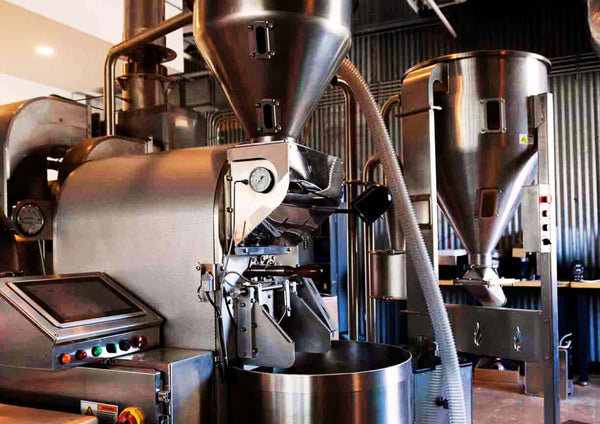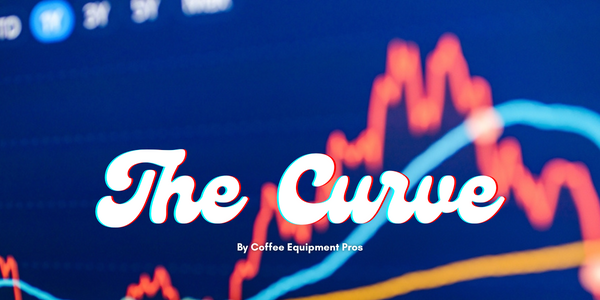
Embrace the Cold Brew Revolution in Your Roastery or Café with a Commercial Cold Brew System
Kristi Anderson-Runge
There’s no denying it: Cold brew has never been hotter. While the classics like espresso, lattes, and drip coffee will always have their place, one caffeinated contender has increasingly been creating ripples in the coffee industry — and that’s cold brew.
What was once a seasonal specialty has transformed into a year-round favorite. So, whether you roast coffee in a wholesale or retail environment, you need to seriously consider adding cold brew options to your product line-up with a commercial cold brew coffee maker or system. Doing so is not only a strategic move that aligns with today’s specialty coffee culture, but it also provides a competitive edge in a dynamic industry.
In this article, we’ll take a look at the rise of cold brew and its money-making and money-saving benefits, consider what to look for in a commercial cold brew system, and provide our recommendations.
Coffee Culture + Creativity = Cold Brew

People have been drinking cold brew coffee for centuries, and it has evolved over time across multiple cultures. When you look at the history of cold brew, you can’t overlook the Japanese Kyoto-style, dating back to the 1600s, and characterized by the slow-drip brewing method using a tower. Resembling a scientific yet elegant drip set-up, the Kyoto-style cold brew is known for its intricate brewing process and the resulting smooth, concentrated coffee.
Let’s talk about that smooth taste for a minute — because something that has been around for centuries obviously has to taste good, right? Unlike hot coffee brewers that release acid during brewing, resulting in a bitter-tasting coffee, cold brewers use cold (or even iced) water to extract a concentrated brew that maintains coffee’s natural flavor. The coffee product cold brewers produce — full-bodied, smooth, and mellow with less caffeine “bite” — makes every moment you wait for it completely worth your while.
In terms of the broader adoption of cold brew in today’s coffee culture, credit is often given to the specialty coffee movement and the third-wave coffee shops that started to popularize unique and meticulous brewing methods over the past decade. Cold brew, with its distinctive flavor profile and preparation process, found a place in this movement, appealing to coffee enthusiasts seeking new and different experiences. And baristas’ creative experimentation with brewing methods continues to produce unique and flavorful cold coffee beverages.
Cold Brew = Money-Maker
Cold brew’s not just a winner with consumers. Coffee roasters and coffee businesses love cold brew for its high-margin reliability and opportunities for brand differentiation. As consumer interest in unique and artisanal coffee experiences grows, businesses that incorporate commercial cold brew systems in order to add cold brew into their product lineup can stand out in a crowded market.
Let’s look at three key factors that contribute to the high-margin nature of cold brew:
-
Convenience and Ready-to-Drink (RTD) Format: Cold brew is often sold in ready-to-drink formats, whether in bottles, cans, or on tap. This convenience eliminates the need for additional preparation by the consumer, making it a premium and easily marketable product perfect for "on the go."
-
Premium Positioning: Cold brew is often perceived as a premium coffee offering due to its unique flavor profile, the specialty nature of the brewing process, and the use of higher-quality coffee beans. This premium positioning allows businesses to command higher prices.
- Diverse Serving Options: Cold brew can be served in various ways, from traditional iced coffee to nitro on tap to creative coffee cocktails. It can also serve as a versatile base for hot coffee drinks like lattes or mochas. Just dilute and heat with water or milk for some of the smoothest coffee you’ve ever tasted. The versatility in presentation and serving options provides opportunities for innovative menu offerings with higher perceived value.
By strategically leveraging these factors, businesses can position cold brew as a high-margin product that not only meets consumer demand for premium and convenient coffee options but also contributes to overall brand profitability.
Cold Brew = Money-Saver
 Not only is cold brew a money-maker, but it can also be a money-saver by streamlining the preparation process and potentially reducing labor costs.
Not only is cold brew a money-maker, but it can also be a money-saver by streamlining the preparation process and potentially reducing labor costs.
Streamlined Preparation
The simplicity of the cold brew process allows for efficient batch preparation. Once the initial steeping is complete, the cold brew concentrate can be stored and used as a base for various beverages, reducing the time needed for individual drink preparation.
Reduced Labor Costs
In terms of labor costs, the streamlined preparation process combined with the potential to batch-produce cold brew can lead to more efficient workflows in your café or roastery. With less hands-on time required for each cup, your staff can focus on providing excellent customer service and attending to other aspects of your business.
In many ways, adding a commercial cold brew system to produce cold brew options can be the ultimate flex for optimizing operational efficiency and enhancing profitability.
Commercial Cold Brew Systems: Factors To Consider
So, we’ve established that cold brew is hotter than ever — and can potentially both make and save you money. Have we convinced you yet that you need to jump on the cold brew train? If so, then we recommend you keep the below five considerations in mind when selecting a commercial cold brew system.
1. Production Capacity
Determine the quantity of cold brew you plan to produce daily. Choose a commercial cold brew system that aligns with your production requirements, ensuring it can efficiently handle the volume you need.
2. Brewing Method and Time
Commercial cold brew systems can use various methods, such as immersion, drip, or pressurized systems. Each method affects the flavor profile and brewing time. Some systems offer rapid brewing, allowing you to produce cold brew quickly, while others prioritize a slower steeping process for enhanced flavor extraction. Choose based on your operational needs and desired taste profile.
3. Filtration System
A reliable filtration system is crucial for producing smooth and sediment-free cold brew. Opt for systems with efficient filters that are easy to clean and replace, ensuring consistent quality.
4. Quality and Space
Look for commercial cold brew systems made from high-quality, food-grade materials. Also, consider the physical dimensions to make sure it fits well within your workspace. Some systems, like TORR Industries’ HIVE CAFÉ, come in a compact design suitable for smaller establishments with limited space.
5. Brand Reputation and Support
Research the reputation of the manufacturer or brand. Read reviews and testimonials from other businesses using the same system. Additionally, consider the availability of customer support, spare parts, and maintenance services.
By carefully evaluating these factors, you can select a commercial cold brew system that not only meets your current needs but also provides room for growth and innovation in your coffee business.
TORR Industries HIVE BREW™ Commercial Cold Brew Systems
Considering the above five factors, if you’re looking for a commercial cold brew system for a small shop or larger commercial operation, we highly recommend the HIVE BREW™ cold brew system product line by TORR Industries — ranging from its manual countertop HIVE CAFÉ ™ system (2-lb batch) and HIVE BREW™ 100 (up to 6-lb batches) to its automatic HIVE BREW™ 400 and HIVE BREW™ 700 systems.
We’re also impressed with the expansion pack option and TORR’s newest addition to the HIVE BREW ™ line: the HIVE FUSION ™ automatic pre-infusion, weigh, and brew cell loading system.

TORR’s cold brewers use a patent-pending extraction process that utilizes a hexagonal, micro-batch brew-cell concept to optimize taste quality, extraction yields, and brew time without taking up as much space as other cold coffee brewing systems. The “HIVE cells” are designed to fit tightly together and can be combined to fit production needs.
Whether you’re an independent coffee shop or roastery or a commercial cold brew coffee company, we think that the HIVE BREW™ commercial cold brew system line is one of the best on the market because it is high-yield, low labor, affordable, and scalable. HIVE BREW™ systems produce 3 gallons of RTD on-demand cold brew in a half hour — or up to 5,000 gallons of RTD per 8-hour shift. These systems can also cold-brew tea, preserving more of its antioxidants and resulting in a smoother, sweeter cup.
What Sets HIVE BREW™ Apart?
Breaks Most Cold Brewing Rules
The HIVE BREW™ process breaks most theories on best cold brewing practices. It uses a smaller grind size, pre-infuses with warm water prior to the brew, controls the drip rate, and doesn't agitate the grounds during the brew. Very different from most other brewers!
Up to 40% Increase in Yield Per Pound
This is achieved by using a patent-pending multi-drip extraction process using micro-batch brew cells that provides 16-22% extraction, compared to a 10-15% extraction rate of dissolved solids for typical immersion brewing.

Fast Brew Times of 15-30 Minutes
Brew times are super-fast at 15 to 30 minutes. Fast brew times retain the unique flavors of your blends. After a quick rinse you are back into the next brew in less than 30 minutes.
Brewing Process Provides High Brix Concentrate at Beginning of Brew
With the HIVE BREW ™ line, the brews start at a high concentration (up to 20 TDS) and are up to "cold espresso" strength. That equates to one quart of espresso-strength concentrate, perfect for iced drinks or affogatos.
Superior Flavor and Longer Shelf Life
The fast brew time and controlled water flow through the grounds allow you to capture the prime attributes of your single origins and blends, providing a superior taste. Being able to brew quickly also provides an extended shelf life compared to slower brewing methods.
Clear Concentrate with Low Turbidity
Since the HIVE BREW ™ systems have no agitation of the grounds during the brew, there’s no need for secondary filtration. TORR’s patent-pending, reusable, stainless-steel filter allows for ease of use and filters out the grounds — eliminating costly throwaway filters.
Brew Cells are Easy to Handle and Clean
A loaded cell weighs less than 20 pounds, making it easy to handle. Cells can be rinsed between brews and sanitized daily.
The HIVE BREW ™ System is Easily Expandable

The HIVE BREW™ 100 (left) is a manual single (1) brew cell unit and requires no power or air supply. It’s easy to set up and uses gravity to control the water flow over the grounds. One operator can produce between 80-120 gallons of RTD in a shift. This is dependent on your dilution of the concentrate. Perfect for coffee shops or small-scale production.

On the other end of the spectrum, the HIVE BREW™ 700 (right) uses the same brew cells as the HIVE BREW ™ 100 and is an automatic seven (7) cell module that can be expanded. It’s a semi-automated production brewer, with its seven cells producing up to 700 gallons of RTD per shift, depending on dilution.
Ready to Join the Cold Brew Crew? We Can Help!
The cold brew revolution is more than a trend; it’s a shift in how people enjoy their coffee. From its smooth, concentrated flavor profile to the refreshing jolt it brings, cold brew has earned its place in the hearts (and cups) of today’s coffee drinkers.
By embracing this movement and investing in a commercial cold brew system, you position your coffee business as a trendsetter. Cold brew not only boosts your revenue but also allows you to engage with your customers in innovative ways.
It’s time to (cold) brew up added success for your coffee business, and Coffee Equipment Pros can help. Feel free to contact us or reach out to Rick directly at 949.289.8083. We can even help you finance your cold brew equipment and explain how the IRS’s Section 179 capital equipment tax write-off can help you leverage your purchasing power.






